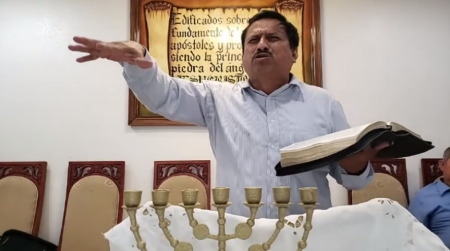After girl, 3, dies in botched exorcism at Pentecostal church, ritual takes spotlight

Officials at a small Pentecostal church in San Jose, California, confirmed that a 3-year-old girl died within their walls last September after undergoing a botched exorcism, bringing a renewed spotlight on the practice of expelling demons from individuals believed to be possessed.
Rene Huezo, who leads Iglesia Apostoles y Profetas where 3-year-old Arely Naomi Proctor died, and is also her grandfather, insists that they were simply trying to follow the Bible when the girl’s mother brought her to the church seeking deliverance from demons.
“If you read the Bible, you’ll see that Jesus casts away demons and made sick people healthy again,” Huezo told The Mercury News in a recent interview. “It’s not when I want to do it, it’s when God, in his will, wants to heal the person. The preacher is like an instrument of God; what we do is what God says.”
The Santa Clara County Medical Examiner’s office ruled that Arely Naomi Proctor’s death was a homicide caused by asphyxiation and arrested her mother, Claudia Hernandez, in January on felony child abuse charges.
According to a police report, at around 8:12 p.m. on September 24, 2021, the San Jose Police Department, Hernandez reported that her daughter passed away at the church located at 1094 S 2nd Street. When police responded to the scene they found, Hernandez, Pastor Huezo who is her father as the child’s uncle.

After the child was pronounced dead at Valley Medical Center at 8:59 p.m., officers learned that “the suspects believed the child was possessed by a demon and they were at the church praying for her.”
Hernandez told police that her daughter was “possessed by an evil spirit” and that “she attempted to stick her finger down the victim’s throat and squeezed the victim’s neck to induce vomiting,” the report said.
The child “fell asleep several times” as Hernandez “pushed down on the victim’s throat with her hand.” Hernandez further stated that her daughter suffered bruises around “her eyes, throat/neck, and chest” during the ordeal. She also told police that they waited for one to two hours after her daughter passed before calling 911.
In a subsequent interview with police, Hernandez revealed that the night before she brought her daughter to the church, she started to believe her daughter was possessed because she “would wake up and scream or cry periodically.”
She said she and her brother prayed for her daughter in a bedroom until they decided to drive her to the church at 6:30 a.m. on Sept. 24.
“Defendant still believed the victim to be possessed. Defendant stated she held the victim around her waist and neck to help her throw up, which she believed would help her get the spirit out. At times Defendant attempted to open the victim’s mouth with her hands. At some point, victim’s grandfather arrived at the church to assist them in prayer,” the police report said. “After that, defendant, victim’s uncle and victim’s grandfather were all holding victim attempting to cause her to vomit. One individual was holding victim by the neck, while one held her around her abdomen, and the last held her around her legs.”
Hernandez and her family then spent several hours trying to induce vomiting until her daughter “vomited a clear/purple liquid.”
She told police that she suspects her daughter, who was given nothing to eat since about 9 p.m. a day earlier, died between 6 p.m. and 6:30 p.m. on Sept. 24.
Days before she was arrested in January, Hernandez told her followers on YouTube,“I could sit here and be negative … be sad about the whole situation that she passed away.
“But it’s like, there is no point because it is what it is. It’s many reasons why God took her. What if something would have happened to her, what if she would have had a sickness? It is what it is. I gotta be positive about the situation. You know, like at least she’s not suffering,” she said. “That’s what I’m thankful for, that she’s not gonna grow up in that world, like in that world we live in.”

According to The Mercury News, Iglesia Apostoles y Profetas meets in the back of a house and serves about 25 members of the local Salvadoran and Mexican community.
Timothy Wadkins, a theology professor at Canisius University, criticized the use of exorcism on a 3-year-old as unusual and relegated the practice to the “radical fringe of Pentecostals.”
“It’s certainly true that the sort of radical fringe of Pentecostals believe in exorcisms and practice them and believe people can be possessed by the devil,” Wadkins told The Mercury News. “They believe that laying your hands on people and calling the devil out in the name of Jesus is a way to rid them of their possessions. You don’t see that too often in Pentecostal circles today, but you do see them in the radical fringe.”
David K. Bernard, author of Spiritual Gifts andgeneral superintendent of the United Pentecostal Church International, which boasts more than 5 million adherents globally and some 800,000 in the U.S., challenged Wadkins’ characterization of the status of the practice of exorcism in the Pentecostal Church.
“All branches of historic Christianity have taught the existence of evil spiritual forces such as demons and have practiced exorcism, or prayer to expel them. The Roman Catholic Church, with which Canisius College is affiliated, still practices exorcism,” Bernard said in a statement to The Christian Post.
“Pentecostals today also practice exorcism. For example, if someone manifests severe spiritual and emotional disturbance in the context of worship, Pentecostals will pray in the name of Jesus Christ for the person to be delivered and healed. They also recognize that many problems can have physical and psychological components or causes, for which they recommend appropriate treatment,” he added. “Probably the professor was referring to aberrant, sensational practices or techniques by fringe groups, which most Pentecostals don’t accept. Nevertheless, most Pentecostals today, not just a fringe group, believe in the importance of prayer for deliverance from forces of evil.”
In the Handbook of Pentecostal Christianity, theologian Keith Warrington also explained that even though they have diverse views about the demonic and exorcism, Pentecostals, in general, accept that the devil and influential demons exist.
Citing multiple Scriptures from the New Testament, Pentecostals maintain that demons, who are ruled by Satan, are antagonistic to God and “often harm those they inhabit, either with an illness or by impelling the victim to self-harm.
Demons are also described as dirty or unclean and evil.
“Since the devil is characterized as being involved in temptation, Pentecostals assume that demons have a similar role, oppressing Christians and initiating negative behavior. Consequently, they subscribe to the view that such malevolent forces need to be excised wherever possible,” Warrington notes.
“Pentecostals believe that casting out demons, or exorcism, is part of the Gospel commission, the authority contained therein being available to all Christians (Matthew 10:8; Mark 16:15-20; Luke 9:1),” he adds.
Pentecostals believe demons attack both Christians and non-Christians through oppression and possession. For Christians, the attack can run the gamut of “temptation, through persistent oppression of the mind, to total control of a specific area of one’s life.”
While non-Christians can be dominated by demons, Pentecostals maintain that Christians can overcome demonic influence with supernatural power they get through prayer, self-discipline and maintaining a close relationship with God.
“Most Pentecostals would accept that, on some occasions, sickness or suffering may be caused by the presence of demons that need to be exorcised (Matthew 9:32-34, 12:22-29; 17:14-21),” Warrington writes. “However, it is not to be assumed that, because an illness was associated with demonic activity in the Gospels (Matthew 12:22-29), such an illness always results from demonic activity (Mark: 31-37).”
It was noted that while the approach to exorcisms can vary among different Pentecostal groups, to prepare for the ritual, those involved in the process usually pray, sometimes fast and lean on the gift of discernment to “diagnose the situation and offer a prognosis.”
“Although a methodology is not prescribed, nor may one be identified in the Bible, the use of the name of Jesus (Mark 16:17; Acts 16:18) and the incorporation of a command that the demon leave its victim (Mark 1:25) are of importance,” Warrington says.
The theologian also warned that believers need to be careful when dealing with exorcisms to avoid “getting this ministry wrong.”
“Although Pentecostals do not distinguish between leaders or clergy and laity functioning in exorcism, they have generally expressed caution in areas relating to the demonic, a caution driven partly by awareness of the dangers associated with getting this ministry wrong,” Warrington says. “Few would claim to have a gift of exorcism, and the role of exorcist has not been adopted within Pentecostalism.”
While exorcisms aren’t very popular in Western culture today, some Pentecostals believe that “the role of the demonic in many Western contexts is more subtle and disguised than elsewhere” Warrington explains.
“Rather than assume that the limited number of exorcisms in the West indicates an absence of the demonic, they argue that the paucity of such phenomena may actually point to the ubiquity of the demonic in the Western world,” Warrington notes. “It is probable, they assert, that demonic activity in the West is even more dangerous by its devious nature; believers must be aware that the battle is not always overt but subliminal and no less undermining. The Bible, the Spirit, as well as other believers are all recognized as potentially playing a significant part in combating demonic activity.”






















